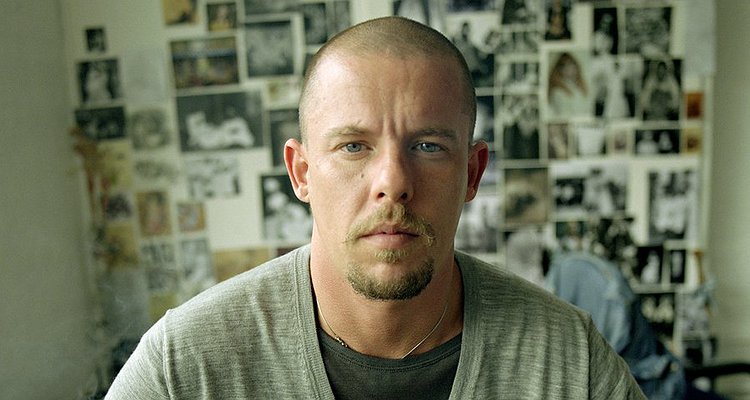How the late Alexander McQueen revolutionised fashion
More than decade on from his untimely death, the gay designer's legacy continues to be felt.
By Will Stroude

Words: Joseph Kocharian
This article first appeared in Attitude issue 263, November 2015.
There is no disputing that Alexander McQueen is a bona fide legend and icon of fashion.
There are not enough superlatives to describe the late designer. His influence on fashion transcends the industry he dominated, seeping into the realms of art, celebrity, provocation and creating a wealth of urban myths that still swirl around him. In short, he created magic.
Born Lee Alexander McQueen to Ronald and Joyce in East London, on 17th March 1969, he always maintained that the fashion world seemed ‘other’ to him.
The youngest of six children, and incredibly close to his mother until her death, he often said that he wasn’t born into fashion, which created an internal disjoint with his relationship with it. Yet his talent was so explosive that he cultivated his idiosyncratic place in the history of fashion greats.
Lee left school at the age of 16, undertook an apprenticeship at Savile Row, moved on to Gieves and Hawkes before moving on to theatre-based Angels The Costumiers.
Meticulous detail and theatrical drama would become a signature of McQueen. His MA show at Central Saint Martins was bought in its entirety by Isabella Blow, who would become an incredibly close friend.
It was Blow that encouraged him to ditch his given name of Lee and instead use his middle name Alexander. McQueen went on become Creative Director of Givenchy whilst simultaneously cultivating his own eponymous label.
He was named British Designer of the Year four times, along with many other accolades in the fashion world.
However conceptual and ostentatious McQueen’s designs were (often taking reference from historical silhouettes and techniques), they also transferred well o the runway, creating a huge scope of influence from celebrity to commercial fashion.
Lady Gaga wore the infamous Armadillo shoes that are unmistakable McQueen in her video for ‘Bad Romance’, while Britney Spears took a liking to his ‘bumster’style jeans which introduced the low slung jean that showed derrière cleavage to the public.
His instantly recognisable skull prints are still a strong identifier of his brand, and influenced a slew of other brands mimicking the popular print on a mass scale.
The clothes he created extended past their exquisite technical construction. Silhouettes were conceptual and had a fully realised world crafted around them, which was nowhere more evident than in the spectacle of his fashion shows. It’s hard to know where to start with the exhibitions that augmented his clothes.
Often visceral, provocative and robust, they have provided not only some of the most iconic moments of McQueen’s career, but of fashion history.
A hologram of Kate Moss appearing ghost-like surrounded by billowing fabric; a model in a dress attacked by spray painting robots; and a human chessboard of models are just a few examples of the spectacles that he put on.
McQueen was also ahead of the curve in terms of not conforming to the body stereotypes of the industry. He caused controversy by using double amputee model Aimee Mullins with prosthetic legs carved out of wood for a catwalk show.
For his show ‘Voss’ in 2001, he forced the audience to stare at their reflection in a mirrored cube for an uncomfortably long time (due to a purposefully delayed show), before eventually revealing Erin O’Connor, Kate Moss and other models trapped in an asylum setting before the smaller cube inside came crashing down to reveal journalist (and former Attitude Features Editor) Michelle Olley, naked, on a chaise wearing a gas mask surrounded by moths.
It made for one of his more visceral shows, and it was this kind of provocation that earned him the title as the ‘l’enfant terrible’ of fashion.
McQueen gave the fashion world plenty to think about aside from his clothing. As the self-proclaimed spin doctor of the industry, you could always rely on him to incept controversy into fashion to keep the voltage high at all times. He once allegedly sewed ‘I am a cunt’ into the lining of a handmade suit for Prince Charles.
Always outspoken, McQueen did not shy away from his sexuality. He said he knew he was gay at the age of six. He came out to his family at the age of 18, and then publically in an interview with i-D magazine shortly afterward.
He married his partner George Forsyth in an extravagant ceremony, way before same-sex marriage became legal. He was bold and articulate about his sexuality from the outset of his profile rising, rather than hiding it.
He focused not on the press, but rather on the people who inspired him. His muses included artists and creators like Sam TaylorJohnson and Björk. Many of them, including Kate Moss, Daphne Guinness and Naomi Campbell attended his funeral after he committed suicide, nine days after the passing of his beloved mother Joyce.
The fashion world is fiercely protective of his legacy. A retrospective of his work, ‘Savage Beauty’, was originally housed in New York which prompted outrage and demand from both friends of McQueen and the public alike that it instead should first go to London – the city where he was was born.
The exhibition eventually made its way to the Victoria and Albert Museum and was extended way past its run to accommodate popular demand.
Lee McQueen was essentially a raw nerve of pulsing talent. In his short life he achieved over a decade of provocative art through the medium of fashion.
A truly tortured genius, his tragic death on 11th February 2010 robbed the world of one of its most exciting and provocative visual artists who seemed to be still on an upward trajectory. The world is unlikely to see his like again.
